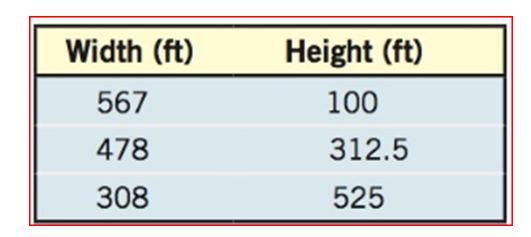
Concept explainers
Gateway Arch The Gateway Arch in St. Louis is often mistaken to be parabolic in shape. In fact, it is a catenary, which has a more complicated formula than a parabola. The Arch is 630 feet high and 630 feet wide at its base.
To find:
a. The equation of a parabola with the given dimensions. Let equal the horizontal distance from the center of the arch.
b. With the given height of arch at various widths; find the corresponding heights for the parabola found in (a).
c. Whether the data support the notion that the arch is in the shape of a parabola.
Answer to Problem 75AYU
a.
b.
c. No.
Explanation of Solution
Given:
The Gateway Arch in St. Louis is often mistaken to be parabolic in shape whose arch is 630 feet high and 630 feet wide at its base.

Calculation:
a. Let us imagine an arch along and let it raise along .
Arch is 630 feet high and is 630 feet wide at its base. Then and lie on the arch.
The equation of parabola would have the form .
Substituting in the above equation we get,
Hence, .
Substituting , we get,
Thus, the equation of the parabola with the same given dimension is
b. To compute the height using the model , we get,
| Width | Height | Points | Height using the model |
c. The height computed using the (from (a)) do not fit the actual heights.
Hence the data does not support the notion that the arch is in the shape of a parabola.
Chapter 10 Solutions
Precalculus Enhanced with Graphing Utilities
Additional Math Textbook Solutions
Calculus: Early Transcendentals (2nd Edition)
A Problem Solving Approach To Mathematics For Elementary School Teachers (13th Edition)
Elementary Statistics
College Algebra (7th Edition)
A First Course in Probability (10th Edition)
Thinking Mathematically (6th Edition)
- x The function f is shown below. If I is the function defined by g(x) = √ ƒ(t) dt, find the value of g"(-8) in simplest form. g -1 8 y 7 10 6 LC 5 4 3 2 1 -10 -9 -8 -7 -6 -5 -4 -3 -2 -1 1 2 3 -1 -2 -3 -4 -5 56 -6 -7 -8 4 5 Graph of f 10 6 00 7 8 9 10 xarrow_forwardThe function f is shown below. If g is an antiderivative of f such that g(6) = 2, what is the maximum value of g on the closed interval [-9,9]? 8 7 6 Сл 5 4 3 1 y Graph of f -10 -9 -8 -7 -6 -5 -4 -3 -2 -1 1 23 4 -1 -2 -3 -4 -6 56 -5 -7 -8 LO 5 9 7 8 9 10arrow_forwardx The function of is shown below. If I is the function defined by g(x) = [* f(t)dt, write the equation of the line tangent to the graph of 9 at x = -3. g y Graph of f 8 7 6 5 4 32 1 x -10 -9 -8 -7 -6 -5 -4 -3 -2 -1 1 2 3 4 5 6 7 8 9 10 -1 -2 -3 56 -6 -7 -8arrow_forward
- Let f(x)=4excosxf'(x)=arrow_forwardThe graph of the function f in the figure below consists of line segments and a quarter of a circle. Let g be the function given by x g(x) = __ f (t)dt. Determine all values of a, if any, where g has a point of inflection on the open interval (-9, 9). 8 y 7 76 LO 5 4 3 2 1 -10 -9 -8 -7 -6 -5 -4 -3 -2 -1 1 2 3 ♡. -1 -2 3 -4 56 -5 -6 -7 -8 Graph of f 4 5 16 7 8 9 10arrow_forwardThe areas of the regions bounded by the graph of the function f and the x-axis are labeled in the figure below. Let the function g be C defined by the equation g(x) = [* f(t)dt. What is the maximum value of the function g on the closed interval [-7, 8]? 17 y Graph of f 00 8 76 5 4 3 2 1 -10 -9 -8 -7 -6 -5 -4 -3-2-1 -2 702 4 1 21 3 4 568 -4 -5 --6 -7 -8 x 5 6 7 8 9 10 17arrow_forward
- A tank holds a 135 gal solution of water and salt. Initially, the solution contains 21 lb of salt. A salt solution with a concentration of 3 lb of salt per gal begins flowing into the tank at the rate of 3 gal per minute. The solution in the tank also begins flowing out at a rate of 3 gal per minute. Let y be the amount of salt present in the tank at time t. (a) Find an expression for the amount of salt in the tank at any time. (b) How much salt is present after 51 minutes? (c) As time increases, what happens to the salt concentration?arrow_forwardSolve please and thanks!arrow_forwardSolve please and thanks!arrow_forward
 Calculus: Early TranscendentalsCalculusISBN:9781285741550Author:James StewartPublisher:Cengage Learning
Calculus: Early TranscendentalsCalculusISBN:9781285741550Author:James StewartPublisher:Cengage Learning Thomas' Calculus (14th Edition)CalculusISBN:9780134438986Author:Joel R. Hass, Christopher E. Heil, Maurice D. WeirPublisher:PEARSON
Thomas' Calculus (14th Edition)CalculusISBN:9780134438986Author:Joel R. Hass, Christopher E. Heil, Maurice D. WeirPublisher:PEARSON Calculus: Early Transcendentals (3rd Edition)CalculusISBN:9780134763644Author:William L. Briggs, Lyle Cochran, Bernard Gillett, Eric SchulzPublisher:PEARSON
Calculus: Early Transcendentals (3rd Edition)CalculusISBN:9780134763644Author:William L. Briggs, Lyle Cochran, Bernard Gillett, Eric SchulzPublisher:PEARSON Calculus: Early TranscendentalsCalculusISBN:9781319050740Author:Jon Rogawski, Colin Adams, Robert FranzosaPublisher:W. H. Freeman
Calculus: Early TranscendentalsCalculusISBN:9781319050740Author:Jon Rogawski, Colin Adams, Robert FranzosaPublisher:W. H. Freeman
 Calculus: Early Transcendental FunctionsCalculusISBN:9781337552516Author:Ron Larson, Bruce H. EdwardsPublisher:Cengage Learning
Calculus: Early Transcendental FunctionsCalculusISBN:9781337552516Author:Ron Larson, Bruce H. EdwardsPublisher:Cengage Learning





